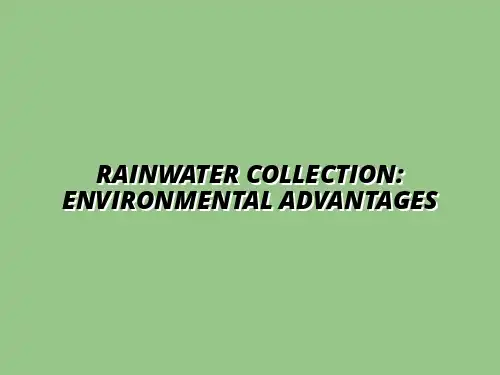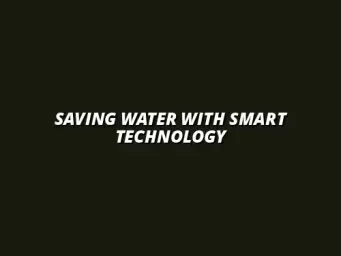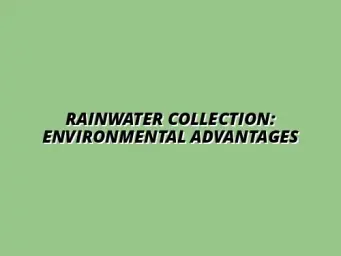The Role of Rainwater Collection Systems in Environmental Sustainability
In today's world, where climate change and water scarcity are pressing issues, rainwater collection systems play a vital role in promoting environmental sustainability. These systems not only provide an alternative water source but also help in conserving the environment. Understanding the components and benefits of these systems can empower individuals and communities to make informed decisions. Learn more about how to harvest rainwater for water conservation and its impact.
Understanding Rainwater Collection Systems
Rainwater collection systems are designed to capture and store rainwater for later use. At their core, these systems consist of several key components, including gutters, downspouts, storage tanks, and filtration systems. Each part works together to ensure that the collected water is clean and usable.
Definition and Components of Rainwater Collection Systems
A rainwater collection system collects water from surfaces like rooftops. The main components include:
- Catchment Area: Typically a roof, where rainwater falls and is collected.
- Conveyance System: Gutters and downspouts that transport water to storage.
- Storage Tank: A container that holds the collected rainwater.
- Filtration System: Ensures the water is clean and free from debris.
How Rainwater Harvesting Works
Once rainwater is collected, it is funneled through gutters and downspouts into a storage tank. From there, the water can be filtered for use in gardens, flushing toilets, or even drinking, depending on the system. This process helps reduce runoff and the potential for flooding, making it beneficial for homeowners and the environment alike. Saving water while washing dishes is another easy way to contribute; check out these tips for saving water while washing dishes.
Exploring the Environmental Benefits
Implementing rainwater collection systems has profound benefits for our environment. By utilizing rainwater, we can significantly reduce our reliance on municipal water systems. This shift not only conserves water but also positively impacts our ecosystems. Discover the numerous eco-friendly plumbing benefits for homeowners too!
Reducing Water Pollution through Rainwater Collection
One of the significant advantages of rainwater harvesting is its potential to decrease water pollution. When rainwater is collected, it minimizes the amount of stormwater runoff that can carry pollutants into water bodies. This reduction can lead to:
- Improved water quality in rivers and lakes.
- Less erosion and sedimentation in waterways.
- A healthier aquatic ecosystem supporting wildlife.
Minimizing Demand on Municipal Water Systems
By using collected rainwater for non-potable uses, we can lessen the burden on municipal water systems. This shift helps preserve drinking water supplies and reduces the strain on treatment facilities. As a result, communities can experience:
- Lower water bills for residents.
- A decrease in infrastructure costs for local governments.
- Enhanced resilience during drought conditions.
Supporting Biodiversity and Ecosystems
Rainwater collection systems not only benefit humans but also support local biodiversity. By providing a sustainable water source, these systems can enhance the health of nearby ecosystems. This helps create a balance between urban development and nature. Regular water heater maintenance is another way to improve water efficiency.
Enhancing Local Flora and Fauna with Rainwater Use
Using harvested rainwater for irrigation can improve the health of local plants. This practice helps sustain gardens, parks, and natural landscapes, promoting growth and biodiversity. Some benefits include:
- Better plant resilience to drought.
- Increased habitat for local wildlife.
- Enhanced beauty in urban settings through lush greenery.
Promoting Soil Health through Natural Irrigation
Natural irrigation with rainwater fosters better soil health. Unlike treated water, rainwater is free from harmful chemicals, allowing for more natural soil conditions. This leads to:
- Improved nutrient retention in soil.
- Reduced salinity levels.
- Enhanced microbial activity, benefiting plant growth.
Addressing Climate Change and Water Scarcity
Rainwater collection systems are crucial in combating climate change and managing water scarcity. They serve as practical strategies that can be implemented at both individual and community levels. By harnessing rainwater, we can adapt to changing environmental conditions. Consider installing a water-saving toilet for further water conservation.
Rainwater Systems as a Strategy for Climate Resilience
By capturing and using rainwater, we can build resilience against climate-related challenges. These systems help communities manage their water resources more effectively, especially during extreme weather events. Key strategies include:
- Storing water during heavy rainfall for later use.
- Reducing the risk of flooding through controlled collection.
- Enhancing drought preparedness with alternative water sources.
Mitigating Urban Heat Islands with Collected Rainwater
In urban areas, rainwater collection can help combat the urban heat island effect, where cities become significantly warmer than their rural surroundings. By using collected rainwater for landscaping and green spaces, we can cool down our cities. Benefits include:
- Lower temperatures around buildings and streets.
- Improved air quality from increased greenery.
- Enhanced comfort for residents during hot weather.
Common Misconceptions about Rainwater Collection Systems
Despite their benefits, many people have misconceptions about rainwater collection systems. Understanding these myths is essential for encouraging more widespread adoption. Let’s clear up some common misunderstandings. Proper plumbing maintenance is key; if you're in Billesley, Birmingham, consider a local plumber.
Addressing Fears of Contaminated Water Supply
Many individuals worry that rainwater might be contaminated and unsafe for use. However, with proper filtration and treatment, rainwater can be as safe as conventional water sources. By implementing a good filtration system, you can ensure:
- Removal of debris and pollutants.
- Safe water for irrigation and even drinking, as per regulations.
- Peace of mind knowing you’re using a sustainable resource.
Debunking Myths about Maintenance and Costs
Another misconception is that rainwater collection systems are costly and difficult to maintain. In reality, the initial investment can lead to long-term savings. Many systems are designed to be low-maintenance, offering benefits such as:
- Reduction in water bills.
- Minimal upkeep if properly managed.
- Increased property value through sustainability initiatives.
Frequently Asked Questions on Rainwater Collection Systems
If you’re considering a rainwater collection system, you might have some questions. Below are some common inquiries I’ve encountered along with their answers. Preventing grease buildup in pipes is crucial for efficient plumbing. Learn more about preventing grease buildup.
What types of rainwater collection systems are most effective?
The most effective systems can vary based on location and needs. Common types include:
- **Rain Barrels:** Great for small gardens, easy to set up.
- **Underground Tanks:** Ideal for larger properties, hidden from view.
- **Above-Ground Cisterns:** Versatile and can store large volumes of water.
How much water can be collected from a typical rooftop?
The amount of water collected depends on several factors, including roof size and rainfall amount. On average, a 1,000 square foot roof can collect:
- About 600 gallons from 1 inch of rain.
- Approximately 3,600 gallons during a typical rainy season.
- Substantial savings and sustainability for households.
Practical Steps for Implementing a Rainwater Collection System
Implementing a rainwater collection system can seem daunting at first, but it’s easier than you might think! The first step is to assess your property to determine if it’s a suitable candidate for such a system. Factors like roof size, local climate, and existing regulations will play a significant role in your planning process.
For instance, a larger roof can collect more rainwater, while areas with heavier rainfall will yield better results. Also, be aware of local laws regarding rainwater collection, as some places have specific guidelines you must follow. This assessment will help you decide the best approach for your needs.
Assessing Your Property for Rainwater Collection Feasibility
When evaluating your property, consider the following factors:
- Roof Size: A larger surface area collects more water.
- Climate: Areas with frequent rain will be more effective for collection.
- Gutter System: Make sure your gutters are in good condition to channel water effectively.
- Local Regulations: Check if there are rules or permits required for installation.
By carefully considering these elements, you can have a clear picture of what to expect from your rainwater collection system. Once you are ready, the next step is to choose the right system that fits your goals.
Choosing the Right System for Your Needs
Selecting the right rainwater collection system is crucial for its effectiveness. Here are some popular options to consider:
- Barrel Systems: Great for small spaces and easy to install.
- Above-Ground Tanks: Ideal for larger collections and easy maintenance.
- Underground Storage: Best for conserving space, but may require more complex installation.
Think about your water needs as well; the size and type of system should match how much rainwater you intend to collect and use. The right choice will ensure that your efforts lead to significant water savings!
Installation Process and Maintenance of Rainwater Collection Systems
Once you've chosen a system, understanding the installation process is key. Here’s a step-by-step guide to help you set it up:
- Gather Materials: Purchase all necessary components like tanks, filters, and gutters.
- Prepare the Site: Clear the area where the system will be installed.
- Install Gutters: Ensure gutters are properly secured to channel rainwater into the collection system.
- Set Up Storage Tanks: Place tanks where they can receive direct rainwater from gutters.
- Connect Filters: Install filters to keep debris out of your water supply.
This installation process may vary based on your chosen system, but these steps provide a solid foundation. After installation, regular maintenance will help keep your system running smoothly.
Essential Maintenance Tips for Long-lasting Efficiency
To ensure your rainwater collection system remains efficient, follow these important maintenance tips:
- Regular Inspections: Check for any blockages or leaks in the gutters and tanks.
- Clean Filters: Clean your filters periodically to maintain water quality.
- Check for Debris: Remove leaves and debris from gutters to prevent overflow.
- Monitor Water Quality: Test the water quality occasionally, especially if using it for drinking.
With proper care, your rainwater collection system will provide you with a sustainable water supply for years to come. Now, let’s look at the long-term environmental impact of rainwater harvesting!
The Long-term Environmental Impact of Rainwater Harvesting
Implementing a rainwater collection system can lead to significant long-term environmental benefits. By quantifying water savings and protecting our environment, we can better understand the importance of these systems. Here are a few ways rainwater harvesting positively affects the environment:
- Conserves Water: Reduces the demand for municipal water supply.
- Decreases Stormwater Runoff: Helps to prevent flooding and erosion.
- Supports Sustainable Practices: Encourages the use of natural resources responsibly.
As we see more adoption of rainwater systems, the cumulative impact on water conservation and environmental protection can be tremendously positive. Let’s dive into some inspiring case studies that illustrate successful rainwater collection projects!
Case Studies of Successful Rainwater Collection Projects
Across the globe, many communities have successfully integrated rainwater harvesting to great effect. Here are a few noteworthy examples:
- Australia: Many homes utilize rainwater systems, reducing reliance on dams.
- India: Rainwater harvesting is common in rural areas, helping families access clean water.
- United States: Various cities have implemented rain gardens to manage stormwater effectively.
These case studies showcase the versatility and effectiveness of rainwater collection systems. They also demonstrate how collective efforts can lead to remarkable environmental benefits!
Encouraging Community Adoption of Rainwater Collection Systems
Encouraging community adoption of rainwater collection systems is vital for sustainable living practices. Raising awareness about the environmental and economic benefits can spark interest among residents. Here’s how to promote the adoption of these systems in your community:
- Host Workshops: Provide hands-on training on installing rainwater systems.
- Share Success Stories: Highlight local and global examples of successful projects.
- Engage with Local Schools: Teach students about sustainability and water conservation.
By actively engaging the community, we can cultivate a culture that values and invests in sustainable water practices! Additionally, offering incentives and programs can further support rainwater harvesting.
Incentives and Programs Supporting Rainwater Harvesting
Many governments and organizations offer incentives to promote rainwater harvesting. These can include:
- Tax Credits: Reductions in taxes for homeowners who implement systems.
- Subsidies: Financial assistance for the purchase of rainwater collection equipment.
- Grants: Funding for community projects focused on sustainability.
Taking advantage of these incentives can make installing a rainwater collection system more affordable and accessible. With increased support, we can all contribute to a greener, more sustainable future!
Summarizing the Environmental Advantages of Rainwater Collection Systems
In summary, rainwater collection systems offer numerous environmental advantages. From conserving water to supporting local ecosystems, these systems play a significant role in promoting sustainability. Here’s a recap of the key benefits:
- Water Conservation: Reduces the demand on municipal sources and preserves natural water cycles.
- Pollution Reduction: Decreases runoff and protects local waterways from contaminants.
- Biodiversity Support: Enhances plant and animal life through natural irrigation.
As we move forward, it's essential to take steps towards implementing sustainable water practices in our lives. Let’s embrace the benefits of rainwater collection and work together for a healthier planet!
Call to Action: Taking Steps Towards Sustainable Water Practices
I encourage you to consider rainwater collection systems for your home or community! Not only are they environmentally friendly, but they also promote self-sufficiency and resilience against water scarcity. By taking action today, we can make a positive impact on our water resources for generations to come!










